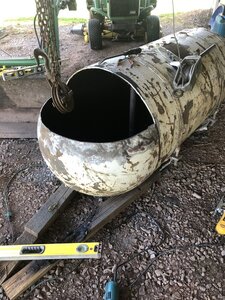40 years ago I thought it would be smart to go against conventionality and build a horizontal hog roaster out of a 275 gal fuel oil tank. My reasoning was that the lower, horizontal design would be easier to load/unload 240 hogs. Additionall, replacing the rotisserie with a stationary grate would provide more real estate for larger cooks. The result was a pretty sleek looking unit that loaded easily and could hold a lot of stuff. It only took one hole hog cook to realize as a rotisserie hog roaster the design would work, just not very well. The shallow wide cooking chamber didn’t heat as efficiently as the tall narrow verticals I had built previously. As a result, cooking time was longer, it used more fuel and flare-ups were pretty interesting. On the other hand, with the large stationary cooking grate installed, it was perfect for roasting turkeys, chicken, and cut meats. Even though it never performed well as a whole hog cooke, I ended up making a lot of money with the grate configuration.
While my experience was with conventional rotisserie roaster designs, the basic lessons would also apply to a reverse flow. I seriously doubt the horizontal configuration would provide enough space to properly install the rf plate and still have room above the grate for a full sized hog. I also am skeptical the wide, shallow cc would allow for the airflow necessary to prevent hotspots across the grate.
Going with a vertical design provides real estate necessary to get you around most of the clearance and airflow issues, but it does limit total size of the cooking grate.
Good luck, keep us updated.









